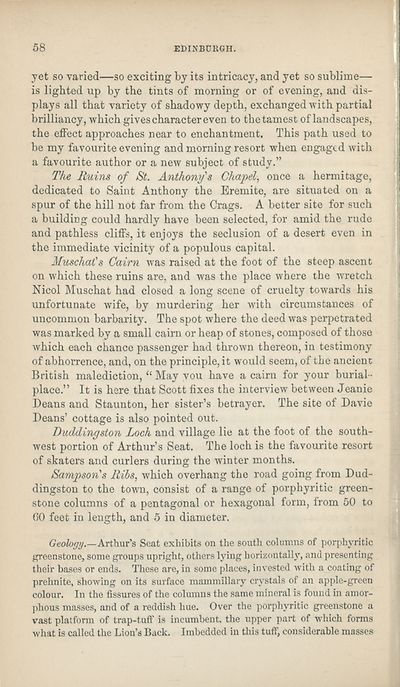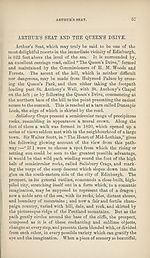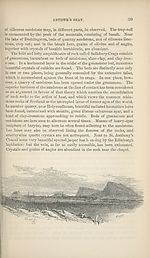Download files
Complete book:
Individual page:
Thumbnail gallery: Grid view | List view

58
EDINBURGH.
yet so varied—so exciting by its intricacy, and yet so sublime—
is lighted up by the tints of morning or of evening, and dis¬
plays all that variety of shadowy depth, exchanged with partial
brilliancy, which gives character even to the tamest of landscapes,
the effect approaches near to enchantment. This path used to
be my favourite evening and morning resort when engaged with
a favourite author or a new subject of study.”
The Ruins of St. Anthony's Chapel, once a hermitage,
dedicated to Saint Anthony the Eremite, are situated on a
spur of the hill not far from the Crags. A better site for such
a building could hardly have been selected, for amid the rude
and pathless cliffs, it enjoys the seclusion of a desert even in
the immediate vicinity of a populous capital.
Muschal's Cairn was raised at the foot of the steep ascent
on which these ruins are, and was the place where the wretch
Nicol Muschat had closed a long scene of cruelty towards his
unfortunate wife, by murdering her with circumstances of
uncommon barbarity. The spot where the deed was perpetrated
was marked by a small cairn or heap of stones, composed of those
which each chance passenger had thrown thereon, in testimony
of abhorrence, and, on the principle, it would seem, of the ancient
British malediction, “ May you have a cairn for your burial-
place.” It is here that Scott fixes the interview between Jeanie
Deans and Staunton, her sister’s betrayer. The site of Davie
Deans’ cottage is also pointed out.
Duddingston Loch and village lie at the foot of the south¬
west portion of Arthur’s Seat. The loch is the favourite resort
of skaters and curlers during the winter months.
Sampson's Ribs, which overhang the road going from Dud-
dingston to the town, consist of a range of porphyritic green¬
stone columns of a pentagonal or hexagonal form, from 50 to
60 feet in length, and 5 in diameter.
Geology.—Arthur’s Seat exhibits on the south columns of porphyritic
greenstone, some groups upright, others lying horizontally, and presenting
their bases or ends. These are, in some places, invested with a coating of
prehnite, showing on its surface mammillary crystals of an apple-green
colour. In the fissures of the columns the same mineral is found in amor¬
phous masses, and of a reddish hue. Over the porphyritic greenstone a
vast platform of trap-tuff is incumbent, the upper part of which forms
what is called the Lion’s Back. Imbedded in this tuff, considerable masses
EDINBURGH.
yet so varied—so exciting by its intricacy, and yet so sublime—
is lighted up by the tints of morning or of evening, and dis¬
plays all that variety of shadowy depth, exchanged with partial
brilliancy, which gives character even to the tamest of landscapes,
the effect approaches near to enchantment. This path used to
be my favourite evening and morning resort when engaged with
a favourite author or a new subject of study.”
The Ruins of St. Anthony's Chapel, once a hermitage,
dedicated to Saint Anthony the Eremite, are situated on a
spur of the hill not far from the Crags. A better site for such
a building could hardly have been selected, for amid the rude
and pathless cliffs, it enjoys the seclusion of a desert even in
the immediate vicinity of a populous capital.
Muschal's Cairn was raised at the foot of the steep ascent
on which these ruins are, and was the place where the wretch
Nicol Muschat had closed a long scene of cruelty towards his
unfortunate wife, by murdering her with circumstances of
uncommon barbarity. The spot where the deed was perpetrated
was marked by a small cairn or heap of stones, composed of those
which each chance passenger had thrown thereon, in testimony
of abhorrence, and, on the principle, it would seem, of the ancient
British malediction, “ May you have a cairn for your burial-
place.” It is here that Scott fixes the interview between Jeanie
Deans and Staunton, her sister’s betrayer. The site of Davie
Deans’ cottage is also pointed out.
Duddingston Loch and village lie at the foot of the south¬
west portion of Arthur’s Seat. The loch is the favourite resort
of skaters and curlers during the winter months.
Sampson's Ribs, which overhang the road going from Dud-
dingston to the town, consist of a range of porphyritic green¬
stone columns of a pentagonal or hexagonal form, from 50 to
60 feet in length, and 5 in diameter.
Geology.—Arthur’s Seat exhibits on the south columns of porphyritic
greenstone, some groups upright, others lying horizontally, and presenting
their bases or ends. These are, in some places, invested with a coating of
prehnite, showing on its surface mammillary crystals of an apple-green
colour. In the fissures of the columns the same mineral is found in amor¬
phous masses, and of a reddish hue. Over the porphyritic greenstone a
vast platform of trap-tuff is incumbent, the upper part of which forms
what is called the Lion’s Back. Imbedded in this tuff, considerable masses
Set display mode to:
![]() Universal Viewer |
Universal Viewer | ![]() Mirador |
Large image | Transcription
Mirador |
Large image | Transcription
| Antiquarian books of Scotland > Scotland/Scots > Black's picturesque tourist of Scotland > (110) |
|---|
| Permanent URL | https://digital.nls.uk/130029510 |
|---|
| Description | Thousands of printed books from the Antiquarian Books of Scotland collection which dates from 1641 to the 1980s. The collection consists of 14,800 books which were published in Scotland or have a Scottish connection, e.g. through the author, printer or owner. Subjects covered include sport, education, diseases, adventure, occupations, Jacobites, politics and religion. Among the 29 languages represented are English, Gaelic, Italian, French, Russian and Swedish. |
|---|

